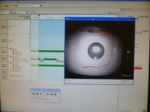

Steffon Williams, Sharon Wise, and Bryant Buchanan. 2017.
The Influence of Artificial Light at Night (ALAN) on Nocturnal Activity of Eastern Red-Backed Salamanders (Plethodon cinereus).
Most organisms have circadian rhythms that regulate many physiological processes. These rhythms are often controlled by environmental light stimuli such as day-night photoperiodic cycles. Disruption of these delicate circadian rhythms with light pollution (artificial light at night) has been shown to have adverse effects on many species. Amphibians are primarily nocturnal and have evolved under low light conditions; so, they are at especially high risk to ncreases in artificial light at night. The eastern red-backed salamander (Plethodon cinereus) is a nocturnal amphibian that lives under rocks and logs in eastern forests. These salamanders emerge from these refugia at dusk and forage until dawn. If darkness is used as a cue for emergence from refugia, then artificial light at night should delay emergence time and impact nocturnal activity.
To test this prediction, we randomly exposed 16 salamanders to 4 lighting treatment groups with day light levels of 100 lx and different intensities of light at night, including 0.0001 lx (dark, control), 0.01 lx (low levels of light pollution), 1 lx (higher level of light pollution), and 100 lx (daylight, control). We used infrared video cameras to record salamander movement continuously for 4 days, and then analyzed 1,536 hours of recordings using Ethovision XT7 to determine when animals emerged from and the amount of time they were active outside their refugia. ALAN suppressed activity of salamanders. Salamanders were significantly less active at all levels of artificial night lighting compared to the normal night lighting control treatment. Salamanders were highly active night 1 in the dark, control treatment but were less active on subsequent nights showing evidence of habituation to the chambers. Salamanders in the 0.0001 lx, 0.01 lx, and 1 lx treatments had distinct circadian rhythms but circadian rhythmicity disappeared in the 100 lx treatment. We conclude that even very small amounts of light at night (0.01 lx) disrupt nocturnal activity of salamanders. Because animals continued to express circadian rhythmicity at 1 lx, it appears that no more than than two orders of magnitude of difference in day and night light levels are necessary to act as a zeitgeber.



